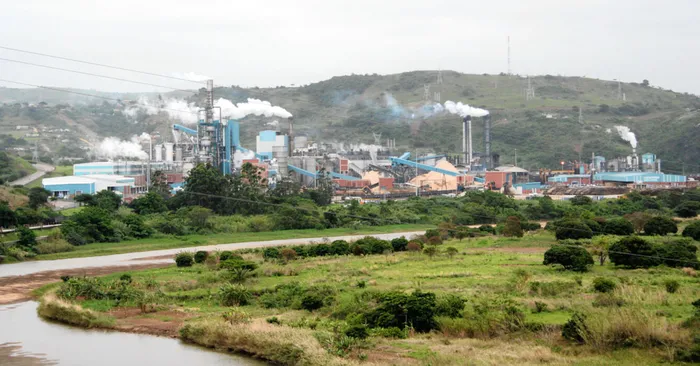Sappi reports $20 million quarterly loss amid planned shutdowns and global economic challenges
Paper and Pulp

The Sappi Saiccor mill near Umkomaas, KwaZulu-Natal, was one of two of the group's South African mills that experienced a longer than expected maintenance shutdown in the quarter to end-March 2025.
Image: Vivian Attwood / Independent Newspapers
Longer than expected maintenance shutdowns at two South African pulp mills and an uncertain global economy saw global paper and packaging group Sappi sink into a loss in the second quarter.
The loss for the three months to March 31 came to $20 million versus a profit of $29m in the quarter to end March last year. Adjusted earnings before interest, tax, depreciation, and amortisation (EBITDA) was $107m versus $180m in the same period in 2024.
“Challenging market conditions across all segments were driven by heightened uncertainty from potential global trade tensions and a broader economic slowdown, which placed downward pressure on selling prices,” CEO Steve Binnie said in an interview with BR.
The forestry fair value price for the quarter was a R307m loss adjustment. Nevertheless, year-on-year sales volumes were stable, with a modest recovery in packaging and speciality paper volumes.
Extended scheduled shutdowns due to additional maintenance in South Africa reduced production in the quarter, which resulted in an additional $13m cost over and above the $45m guidance.
These issues were resolved, and the Saiccor and Ngodwana Mills were running well post start-up. The quarter was also affected by the extended shutdown for the conversion and expansion of Somerset Mill PM2 in North America, which was $20m as per guidance, said Binnie.
The capital expenditure forecast for the year had risen to $550m due to the delay in the start-up and increased labour costs at the Somerset Mill PM2 project. Net debt was expected to peak in the third quarter, as the capital expenditure for the project was completed.
He said the group aimed to reducing net debt to an immediate target of around $1 billion. In the period after the third quarter, said Binnie.
Net debt of $1.67bn increased by $264m. This was due to net cash utilisation and negative currency translation effects from a weaker US dollar on our Euro-denominated debt. Liquidity comprised $156m cash and $612m from revolving credit facilities.
He said that targeted efforts to grow market share in graphic papers delivered positive gains. Amid the macroeconomic challenges, the focus was to optimise asset use, and on cost-saving initiatives to support future performance.
Binnie said markets remain uncertain due to global trade tensions, particularly the tariffs imposed by the US on textile and apparel manufacturers in China, which was impacting demand and pricing for dissolving wood pulp (DWP).
“We are adopting a cautious outlook and estimate that adjusted EBITDA for the third quarter will be at a similar level to that of the second quarter,” said Binnie. While the direct impact of the currently proposed US tariffs was expected to be relatively limited on the group, it was their broader impact that could impact the group, he said.
He said, however, he expected DWP prices to bounce back, although he was not sure when, because, for example, DWP was used to make clothes in China, which were exported to the US, and large US retailers would eventually require their merchandise for their stores.
Demand for DWP remained steady during the quarter, but the typical seasonal boost in demand post-Chinese New Year was not observed as textile and apparel markets slowed. VSF pricing consequently saw a $70 per ton decline in the hardwood DWP market price.
Packaging and speciality paper segment sales volumes increased 9% year-on-year, reflecting a normalisation of inventory and modest recovery in demand in North America and South Africa.
Graphic paper sales volumes remained relatively stable year-on-year, despite the ongoing structural decline in market demand, reflecting positive market share gains for Sappi. The segment continued to operate in an oversupplied environment.
The European business remained under pressure due to persistent macroeconomic weakness and the significant oversupply in paper markets. Whilst sales volumes were relatively stable year-on-year, margins were adversely affected by lower selling prices.
BUSINESS REPORT